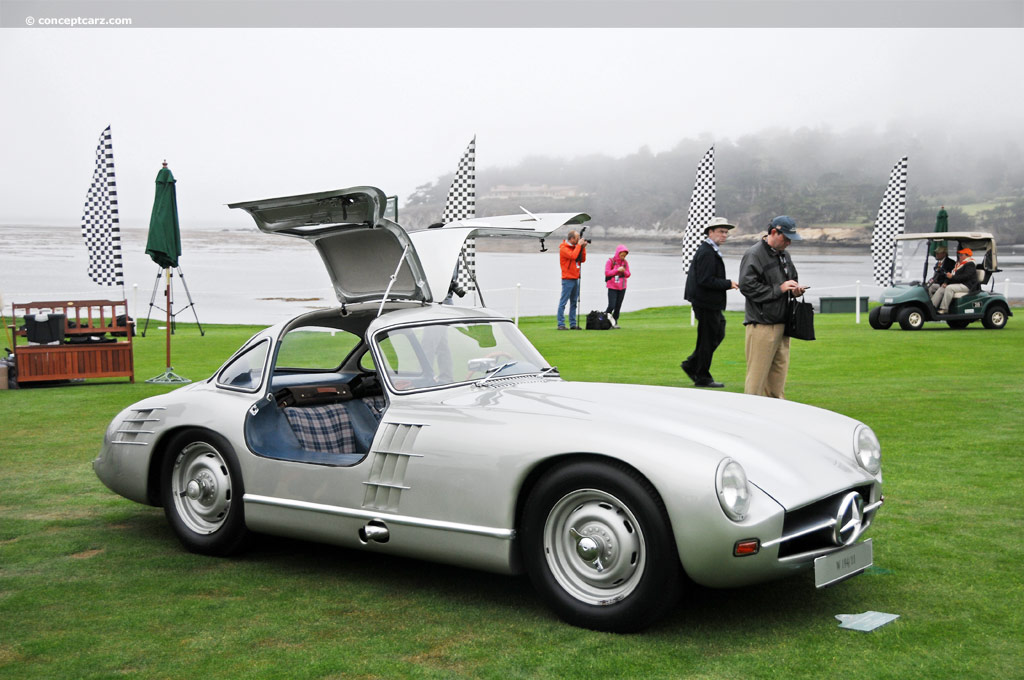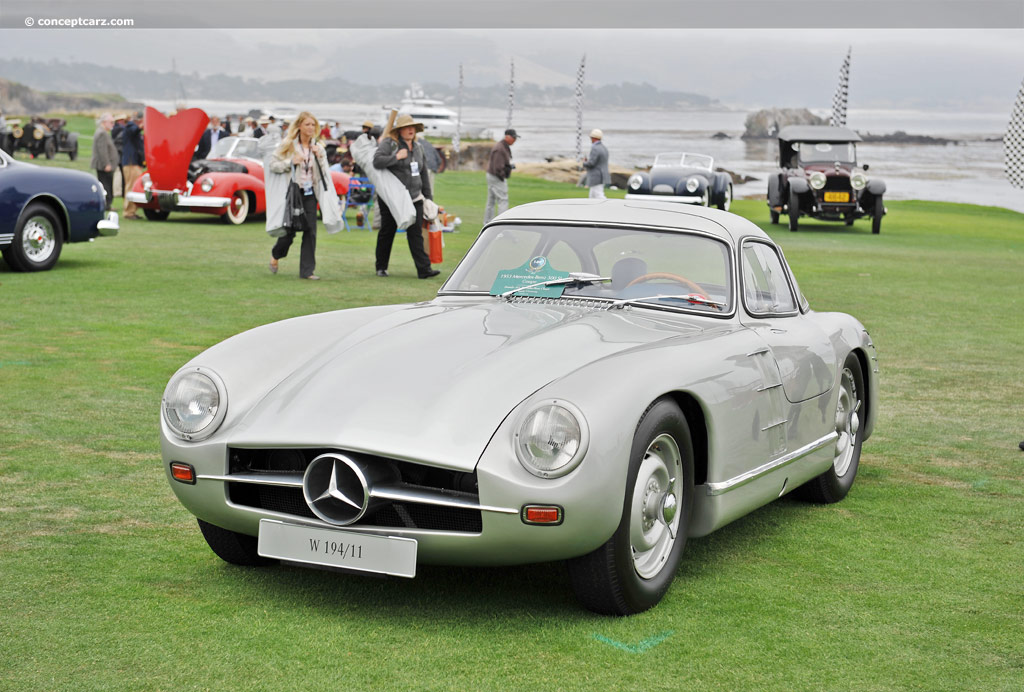While higher volume production automobiles occupied much of Mercedes-Benz focus during its initial post-war production efforts, plans were underway for a new top-of-the-line car that could occupy the same position in the model line as the pre-war 770K Grosser. Re-establishing its pre-war motorsport prowess was equally paramount, and as the 1950s came into view, Mercedes-Benz began development work to achieve that goal. At the time, the company's largest engine was the M186 used to power the 300 'Adenauer' saloon (W186) and the exclusive 300 S two-seater tourer (W188). A suitable starting point, the overhead cam straight-6 M194 engine used triple two-barrel Solex carburetors and an innovative diagonal aluminum head, positioned at a fifty-degree angle, designed to accept larger intake and exhaust valve. It was installed in a welded aluminum tube spaceframe chassis that weighed approximately 140 pounds and was designed by the company's chief developing engineer, Rudolf Uhlenhaut. It was lightweight, strong, and offset the relatively underpowered M194 engine. Its design enveloped the passenger compartment making traditional doors impossible to use, resulting in the exotic and distinct gull-wing doors.
Coupe
Chassis #: 001/52
View info and historyWhile the engine powering the 300 S developed 150 horsepower, the racing version was tuned to produce 175 horsepower, enough for a top speed of approximately 160 mph. Underpowered compared to numbers produced by the competition, the W194 relied on agility, lightweight construction, durability, technology, and aerodynamics. The all-wheel independent suspension provided excellent handling and comfort, albeit offset by the large fuel tank capacity that could be detrimental to handling depending on the amount of fuel onboard. Additionally, the rear swing axle was connected only at the differential and not at the wheels themselves, allowing extreme changes in camber that could be dangerous at high speeds. Nevertheless, it was far superior to many other sports cars of the era, and many of the early successes were on high-speed open road courses. Responsive steering, low weight, and low aerodynamic drag overcame the underpowered engine, giving the W194 a competitive edge in endurance competition.The first outing was at the 1952 Mille Miglia where it scored second and fourth-place finishes. It swept the top three places at the Bern Sports Car Prize 131.04 kilometers, and placed first and second at the 24 Hours of LeMans, with Herman Lang and Fritz Riess averaging 155.6 km/h to secure top honors. The second place was secured by Theo Helfrich and Helmut Niedermayr. Additional victories were scored at the sportscar race of the Eifelrennen at the Nürburgring, and in Mexico's Carrera Panamericana. Karl Kling and Hans Klenk won the Carrera Panamericana despite having a vulture fly through the windscreen. Ten examples of the W194 were manufactured, with nine of them used for competition, and chassis number 002 served as a parts and training car. 
Coupe
Chassis #: 001/52
View info and historyIn preparation for the 1953 season, numerous changes were made, including the use of 16-inch wheels, the gearbox was moved to the rear axle, and fuel-injection replaced the three-carburetor setup. Elektron, a magnesium alloy, was used to create the bodywork resulting in a reduction of weight of the early W194 by 85 kilograms. It was further refined through wind tunnel testing resulting in a new face and improved airflow through the engine compartment. This unique vehicle, chassis number 0011/52, remained a working prototype and was never raced. Because of its different front end, Mercedes-Benz referred to it as the 'carpenter's plane.' Much of its design, with its compact dimensions, ventilation fins, and angular radiator, foreshadowed the 300 SL production sports car soon to come.An individual named Maximilian (Max) Edwin Hoffman became instrumental in the development of several luxury sports cars during the 1950s, including the 300 SL Gullwing, Porsche 356 Speedster, and the BMW 507 roadster. He was able to recognize a market where it didn't yet exist and was able to entice manufacturers into making his vision a reality. During a director's meeting in Stuttgart in 1953, Max Hoffman suggested that American performance enthusiasts would eagerly buy a road-going version of the Grand Prix car. An order was placed for 1,000 examples giving birth to the 300 SL, introduced at the New York Auto Show in 1954. Additionally, Hoffman placed another order for 1,000 examples of a smaller Roadster version called the 190 SL. Both examples were put on display at the International Motor Sports Show in New York, and serial production began in August of 1954 at the Sindelfingen plant.
Coupe
Chassis #: 001/52
View info and historyThe Mercedes-Benz 300 SL used the tubular frame set up on a steel chassis, with a steel body attached to the frame. Many of the body components were formed from aluminum, including the boot lid, doors, bonnet, and dashboard. Additionally, for a fee, the entire body could be formed from aluminum, reducing weight by an additional 80 kilograms (175 pounds). Just 29 of these aluminum-bodied examples were built.The water-cooled 3.0-liter M198 engine had two valves per cylinder, an aluminum head, a Bosch mechanical direct fuel injection system, and delivered nearly 25-percent more horsepower than the W194's two-barrel Solex carburetor setup, with 240 horsepower at 6,000 RPM. To ensure proper oil distribution at high-speed cornering, and to reduce engine height through the elimination of a traditional oil pan, the engine was fitted with a dry-sump lubrication system. The standard compression was set at 8.55:1, with an optional and more powerful version available with a 9.5:1 compression ratio and Sports camshaft. The engine was backed by a four-speed transmission with a single-disc dry clutch and a standard rear axle ratio of 1:3.42. After the first 41 cars were built, this axle changed to 1:3.64 for improved acceleration. 
Coupe
Chassis #: 001/52
View info and historyThe interior included a checkered pattern seat fabrics as standard, however, most customers selected the optional leather upholstery. Due to the chassis and gull-wing doors, the coupe had a high sill, making exit and entry difficult. To resolve this issue, Mercedes-Benz engineers installed a steering wheel that could pivot on its hub 90 degrees away from the dashboard. Along with the high sill, another drawback on the coupe's was the fixed windows. Storage space was adequate, with space for luggage behind the seats and additional space in the trunk when the spare wheel was removed. The suspension used double, unequal length wishbones with coil springs and hydraulic telescopic shock absorbers and a torsion bar stabilizer. Braking was provided by self-cooled, turbo drum brakes with a brake booster that reduced the pedal force. The rear drum brakes had one wheel brake cylinder per wheel, while the front brakes had two.The W198 Coupe (300SL) holds the distinction as being the first gasoline-powered car to be fitted with a direct fuel injection system. With a top speed of 130-155 mph, the 300SL was one of the fastest vehicles of the 1950s. Its performance, design, reputation, and futuristic 'Gullwing' doors were all factors in the success of the vehicle. Its low-slung frame, wide-mouth grille, fighter-plane cockpit, and the fuel-injected engine is credited for changing the company's image in America from a manufacturer of solid, but staid, automobiles to that of a producer of sporty cars. By the time production ended in 1963, a total of 1,400 coupes and 1,858 roadsters were built.
by Daniel Vaughan | Sep 2020

Coupe
Chassis #: 001/52
View info and history

Coupe
Chassis #: 001/52
View info and history

Coupe
Chassis #: 001/52
View info and history

Coupe
Chassis #: 001/52
View info and history
by Daniel Vaughan | Sep 2020
Related Reading : Mercedes-Benz 300 History
With a top speed of 130-155 mph, depending on the axle ratio, the 300SL was one of the fastest vehicles of the 1950s. Its performance, design, reputation, and futuristic Gullwing doors were all responsible for the success of the vehicle. The SL represented Sport Leicht or Sport Light. An American Max Hoffman is partly responsible for the mass-production of the 300SL. He had urged Mercedes-Benz....
Continue Reading >>
Continue Reading >>
Related Reading : Mercedes-Benz 300 History
The Mercedes-Benz 300 was produced from 1951 through 1958 and is one of the most graceful and classic creations of the post-World War II era. The style was both classic and modern and built to high standards. They were constructed from fine materials using the latest in technology and achieving minimal weight with a high degree of strength. The 300 was built on a traditional body-on-frame construction....
Continue Reading >>
Continue Reading >>
Related Reading : Mercedes-Benz 300 History
Eternal youth is a miracle bestowed on only a small number of cars, and the Mercedes-Benz 300 SL coupe is one of this elite group. The Stuttgart-based brand unveiled its new sports car in February 1954 at the International Motor Sports Show in New York, and in so doing lit the fuse for an icon of the automotive world. With its flat, graceful body, the 300 SL had lost nothing of its freshness even....
Continue Reading >>
Continue Reading >>
Related Reading : Mercedes-Benz 300 History
Large and luxurious, the Mercedes 300 series was built from 1951 until 1957 in its original form. The companys largest and most-prestigious models, the Mercedes-Benz Type 300 is considered a trademark of the era throughout the 1950s. With a 3 liter engine capacity, the name 300 said it all. Exclusive, expensive, elegant and full of power, the Type 300 vehicles were in an elite status all of its own.....
Continue Reading >>
Continue Reading >>
Similar Vehicles
Similarly Sized Vehicles
from 1953
1953 Mercedes-Benz 300 SL Vehicle Profiles
Recent Vehicle Additions
Performance and Specification Comparison
300 SL Specification Comparison by Year
Year
Production
Wheelbase
Engine
Prices
94.50 in.
Related Automotive News

Roadsters and Gullwings at the Mercedes-Benz Sale
The 300 SL - be it Roadster or Gullwing – is one of the most recognizable models in the history of Mercedes-Benz. On 28 March, four pristine examples of this motoring icon from the 1950s and 1960s will go under the hammer at the single-marque Mercedes-Benz...

STRIVING FOR VICTORY AND PERFECTION: BMW GROUP CLASSIC AT TECHNO CLASSICA 2014
Munich Essen. Techno Classica takes its place as the worlds largest and most important gathering on the vintage, classic and recent classic calendar once again this year, with more than 1,250 exhibitors from 30 countries presenting their vehicles...

Techno Classica 2014: more than 30 racing cars to celebrate 120 years of Mercedes-Benz motor racing history
Cars that were the heroes of magical moments put their stamp on this high-powered, most comprehensive show presentation
With more than 30 vehicles, Mercedes-Benz Classic presents motor racing history in all its unique breadth and depth
120 years o...

Anniversary Race Through Patagonia: Bmw Group Classic Lines Up With Three Historic Cars For The '1000 Millas Sport'
Anniversary race through Patagonia BMW Group Classic lines up with three historic cars for the 1000 Millas Sport in Argentina.
BMW 328 Kamm racing saloon, BMW 2000 CS and BMW 3.0 CS add further allure to the starting field for the 25th edition o...

Goodwood Festival of Speed 2013: auction of Mercedes-Benz W 196 R one of highlights at world's 'largest motorised garden party'
Mercedes-Benz Classic presents great moments in motor-racing history at Goodwood
Motorsport festival celebrating its 20th anniversary
Auction of only privately owned post-war Silver Arrow by Bonhams sure to cause a stir
Stuttgart – This...











